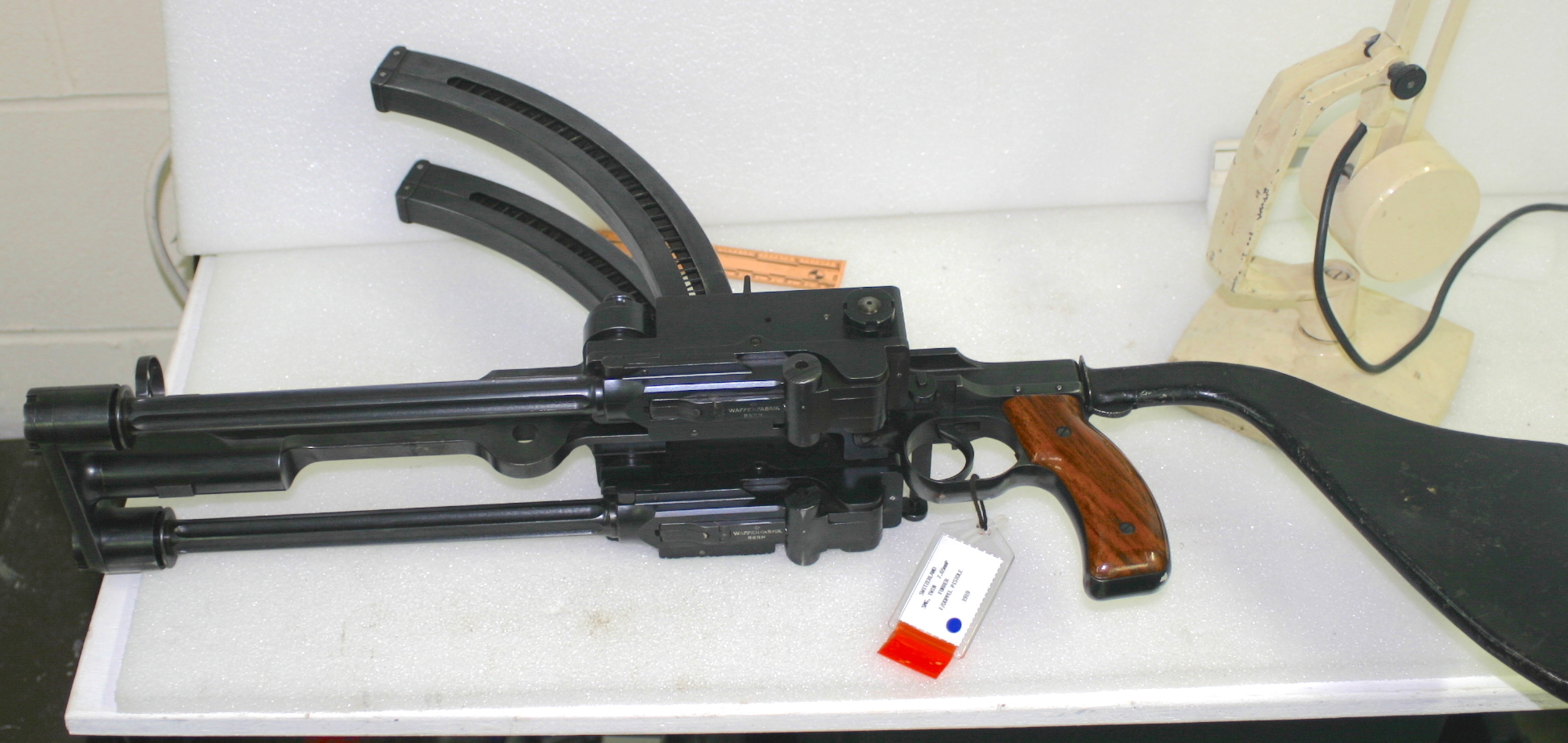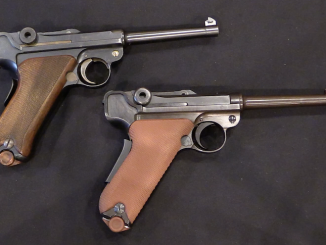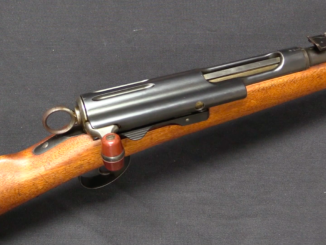The Swiss military discovered an urgent need for submachine guns in the early years of World War II, and sent out a very short-notice request for SMG designs. This seemed like the perfect opportunity for the SIG concern, which had been development a very good line of submachine guns through the 1930s. Their only serious competition was the WF Bern factory, which did not have anything of the sort in production. However, the director of the Bern plant (Adolph Furrer) was politically connected and make an energetic effort to promote a gun of his own design. Furrer had been tinkering with toggle locked designs for several decades, and had designed the Swiss LMG-25 machine gun. He claimed that his own submachine gun would be lighter, simpler, cheaper, and just all around better than SIG’s…despite the fact that he didn’t actually have it in production yet.
Unfortunately for the Swiss, Furrer’s arguments worked, and Bern ended up with a contract for what would be designated the MP41. It was a short-recoil, toggle-locked gun using a side-mounted 40 round single-feed magazine and firing at a rate of 850-900 rounds/minute. Predictably, production delays meant that the threat of German invasion was completely gone by the time a substantial number of the guns were actually delivered. The Swiss military would honor his contract, but lost patience in 1943 and obtained a production license for the Suomi SMG from Finland, and would produce more MP43/44 Suomi guns than Furrer guns. The MP41 was slightly updated in 1944, and would remain in Swiss service until the mid 1970s, when they were removed from inventory and almost all scrapped (because no other country was interested in buying them).
Thanks to Kessler Auktionen AG for letting me film some of their guns – if you are looking for interesting and unusual arms in Europe, make sure to check them out!




Makes you wonder what Sig would have come up with…
Photo of SIG competitor is available here: https://wwiiafterwwii.wordpress.com/2016/07/31/mp-4144-submachine-gun-post-wwii-use/
“Adolph Furrer”
All known to me source give him name as Adolf (or in full Johann Adolf Furrer-Kägi)
He seems to have long*-lasting believing that his system is best and could be applied to weapons of any size. Sub-machine gun format proved to be technically possibly but unnecessary taking in account blow-back principle. Bigger weapons using his principle proved more reasonably (W+F Lmg 25, 24 mm Tankbüchse 41, 20 mm aircraft autocannon, 34 mm AA gun, 7,5 mm aviation machine gun)
* – at least since 1919, see: https://www.forgottenweapons.com/submachine-guns/furrer-1919-smg/ also notice that when his sub-machine gun was introduced into 1941 he was already 68 years old, which might explain why his sub-machine gun looks something outdated.
Ugliest SMG ever? I assume you meant to add “excluding the Australian Owen.”
At least include the sputter gun on your list of ugly guns. It had no trigger at all! Thankfully it was a failure.
“Ugliest SMG ever?”
This Swiss sub-machine gun is more-or-less shrink down LMG, including aesthetics, it might look somewhat old aged when compared to other sub-machine gun introduced in 1941, but IMHO it goes well with… how to name it? spirit of Switzerland, showing similarities with other Swiss fire-arms of that area.
IMHO high ranking in ugliest sub-machine gun is EMP 44:
https://en.wikipedia.org/wiki/EMP_44
it was never adopted, but if it would, it would probably give shock when supplied to soldiers accustomed to high-tech (if I could say so) and good finish of German technology, looking like something haphazardly welded from random pieces of metal and more like resistance makeshift weapon than weapon of soldier of invincible 1000-year Reich.
Daweo wins the ugliest contest with the EMP 44.
Not even close.
The Owen isn’t even in the first rank, nor is the Furrer MP41/44.
The ugliest SMG ever was the experimental Mendoza of 1957. It looked like half a gun, chopped off behind the pistol grip, because it was a blow-forward like the Japanese Hino-Komura experimental self-loading pistol of 1902. You’d think that by 1957, the designer of the Mendoza light machine guns, two of the best in history, would have known blow-forward was a non-starter. All of his later designs for SMGs were overhung-bolt types on the Vz23/Uzi principle.
Next up was a Swiss product, the Rexim-Favor SMG. All versions were fairly gnarly, but the Turkish Army variant hits some sort of high point for baroque hideousness. What other SMG has both a pistol-grip and a semi-pistol grip stock, plus a switchblade bayonet?
http://www.imfdb.org/images/7/71/Rexim-Favor-Turkish-Army.jpg
Then of course there’s the Spanish Labora SMG, which looks like an apprentice blacksmith ran it up from a couple of hunks of pipe and some scrap wood while the boss was out to lunch;
https://78.media.tumblr.com/d8ec8d244aad4ceaeee8caa52fc7e7b2/tumblr_mw6c3s8MKv1s57vgxo1_540.jpg
Compared to these critters, the Owen is a work of art. Actually, compared to almost any other SMG the Owen is a work of art, because as odd-looking as it is, it keeps working in almost any conditions.
cheers
eon
As for weird, what about the MAK-22 semi-auto AK look-alike? For a rim-fire gun, it looks “scary” but it probably doesn’t live up to its “war-mongering” appearance.
There are several Russian SMGs around today that out-weird it, notably the PP2000;
https://modernfirearms.net/userfiles/_thumbs/Images/smg/smg61/pp2000_01.jpg
One seriously weird item is the South African Vector CR-21, which under its refugee-from-a-Star Trek-
series skin is really just an R4 Galil clone;
https://upload.wikimedia.org/wikipedia/commons/e/ee/Vector_cr-21.jpg
And like most bullpups, it’s a right-shoulder-only proposition. One more reason the breed is dying out.
Rifles, pistols and shotguns look the way they do for the same reason that the wheels on a car are on the underside rather than the roof.
Because that’s how they have to look to actually work.
cheers
eon
“Because that’s how they have to look to actually work.”
PP-2000 has such shape, because trigger guard is designed to also work as front grip (cf. Agram 2000)
“Because that’s how they have to look to actually work.”
Here Solothurn S17-100 is interesting case, it was sub-machine gun to be fired from tripod (or vehicle) ONLY, no fore-end/grip/furniture for firing from shoulder: http://www.brpguns.com/blog/mount-my-subgun/
Yes, the “tactical tuna fish” or perhaps “fugu/boko blow-fish/puffer fish” of small arms design must go to the S. African Vector CR21 and the FN 2000 5.56mm with its odd “toilet seat cover” that pops up in order to view the otherwise invisible chamber area. Still, if one had to do some shooting after very extended slithering through mud and sludge, I suppose there’d be an argument for it.
I’m fascinated by what eon calls the “non starter” blow-forward designs, including the weird Coenders last-ditch prototypes in one or another of those books on Ian’s enviable book shelf what with boxes of obscure cartridges used as book ends. I have never seen the Mendoza prototype of which eon writes? I have seen the magazine-in-pistol-grip á la Sa23-26 9mm and 7.62x25mm SMGs and the Uzi. Does anyone have superior “google-fu” skills, or is able to suggest a printed reference? I do like the gripping surface on the overhanging bolt of the Mendoza HM2 and 3, which dispenses with a protruding bolt handle and allows for the bolt to be “racked” much like a semi-auto pistol slide. Something also found on the “non starter” Madsen m/45 9mm SMG that was sold in very limited numbers to some Mexican police and El Salvador, while the later M50 was rather more successful and even almost saw consideration as a “PDW” by the UK!
A-ha! or “eureka!” or “C’est ça!”:
I found your reference from some years ago, eon:
” December 1962 issue of Gun World magazine, an article by William B. Edwards titled “Burp Guns of the Modern Armies” includes (bottom p.29) two photos of an SMG designed by Rafael Mendoza, of RM-1/2 LMG and HM-3 SMG fame. ”
I’ll just go and see if I can find that issue, I guess. If not on “Forgotten Weapons” then where else?!
“Coenders last-ditch prototypes”
Some photos of such weapons are available here:
https://raigap.livejournal.com/365591.html
according to Coenders co-worker 7,9 x 57 machine gun has Rate-of-Fire 2200…2400 rpm. High Rate-of-Fire seems to be inherent for blow-forward designs; too high for most sub-machine gun.
““non starter” blow-forward designs”
In early 1960s Izhevsk plant was searching on how to make avtomat fire with better accuracy in full-auto, they concluded that it depend mainly on parameter called суммарный импульс отдачи (English name unknown to me), they crafted following… hmm… technology demonstrator and measured that parameter which give following results:
gas-operated (AKM-style): 0,4
barrel moving forward: 1,2
long-recoil: 0,1
so they proceeded with that last
“like a semi-auto pistol slide. Something also found on the “non starter” Madsen m/45”
For earlier sub-machine gun (assuming earlier equals patented earlier) with at least 1 example made and wrap-around moving mass around barrel, see 1917 Walther proposal for sub-machine gun competing with Bergmann: https://raigap.livejournal.com/463623.html
it was supposed to be feed from pan magazine akin to Lewis, lost to Bergmann due to being more complicated (including magazine) and less optimized for production.
I *think* this is the early Mendoza .45 acp SMG design:
https://imgur.com/a/yTHOp
“Compared to these critters, the Owen is a work of art.”
I would say: OWEN looks very reasonably when compared to other Australian invention of that era, namely Andrews machine carbine (also known as BSA-Andrews after manufacturer of prototype):
http://firearms.96.lt/pages/Andrews%20machine%20carbine.html
The Andrews looks like it was intended as a type of “folding” or concealable SMG. While of little application in jungle warfare, where the Owen worked perfectly, it would have been a tool usable for all sorts of things by resistance fighters in occupied Europe, notably in urban areas.
Note that one reason the Sten MK II was preferred to all other Marks by the French resistance was that it could be broken down into its components- receiver and action, barrel, stock, and magazine- very quickly and easily for concealment. No other Sten, and few other SMGs of the era, had that attribute.
The MK III by comparison had its barrel and receiver in a single unit, and only the stock was removable. Easier to make, harder to stash.
cheers
eon
Also “too disposable” in the sense that the barrel trunnion was permanently pinned to the rolled sheet metal receiver. Thus, if the barrel had to be replaced, the entire barrel and receiver were scrapped–thus the entire weapon, while the Mk.II could simply have another barrel fitted. All of your points are well taken, certainly. I do believe the initial idea was for the Sten Mk.III to become the standard of UK-based territorials and the entire Home Guard, with the Thompson retained by commandoes and the Mk.IIs freed up for front-line use. In the event, I’ve seen any number of Mk.IIIs in front line use too…
Say what you will, but I think that having the spare magazine as an extemporized butt-stock is pretty slick!
“Ugliest SMG ever?”
Sten Mark I ?
I see this mechanism as a compound toggle with 3 links. The rear 2 links form a folded toggle like the Schwarzlose HMG. The center and forward link form the more common knee joint toggle. My best guess is that this was done to keep the action narrower than just a knee joint would allow.
Query in modern firearms has diagram explaining working of Furrer system:
https://modernfirearms.net/en/submachine-guns/switzerland-submachine-guns/wf-lmg-pist-4144-eng/
Thanks, I did mot notice that the center link was pinned to the barrel extension.
“My best guess is that this was done to keep the action narrower than just a knee joint would allow.”
Also, from linked query: main gimmick of Furrer is system that bolt and barrel are mechanically linked all the time (with leverage as for part of cycle bolt needs to move faster than barrel), unlike Maxim toggle system when bolt movement is independent from barrel after unlocking.
A couple points elicited by this highly entertaining excursion into firearms over-engineered… A $5k 9mm SMG in the midst of WWII!
I once got to watch a Swiss army training film from the Cold War-era. The Home team (“yay! Go Switzerland!”) wore the stahlhelm M18, engineered in the US of A by experts designing steel helmets before U.S. entry into WWI and ultimately rejected because a) too expensive in comparison with “good enough” Brodie style, and b) looked to German. They wore the crazy “Alpenflage” camouflage scheme, which apparently harkens to a late-war German pattern, and they were packing the StGw57 roller-locked automatic rifles. The Away team–(“boo! Boo these men! faux-Warsaw Pact”) had the Hispano-Suiza MP43/44 as stand-ins for the PPSh and/or Kalashnikov, the regular gray fatigue uniform, and the brand-new (at the time) stahlhelm M71.
2. The Swiss “national redoubt” in the southern Alpine cantons apparently had a role in the thinking of the Western Allies that the Germans, in their prolonged Nazi-led national suicide pact were going to similarly withdraw into an alpine rampart at the end of the war. Before the Rhine barrier had been breached, and with the disasters of Market Garden, Hürtgen forest, and Aachen in mind, Stalin–evil cynic that he was–broached the issue of outflanking the Rhine along the southern headwaters by going through Switzerland at one of the Allied conferences. Had the Swiss withdrawn into the fortresses, one might wonder if that path would have lain open vs. the opportune capture of the intact bridge at Remagen.
Ugliest SMG? Hmm… Personally, I find the Rexim-Favor quite hideous and to me the retro-futuristic MP38/40 seems sinister indeed.
Fascination? I rather call this obsession …
Knowing the history of Adolph Furrer and the company he was chairman of makes the decision of taking this SMG into service more easy to understand.
W+F was a state-owned industrial complex, just like Spingfield Armory. They already made the LMG 25.
Furrer himself was in the rank of Brigadier General.
Of course was it more easy for the military leadership of that time to decide for the product of a state-oned company …
Also was it unimaginable to decline the work and show distrust in the words of a high-ranking officer.
“Fascination? I rather call this obsession”
Interestingly, need to fit into weight limits forced Furrer to use stock made from Bakelite (polyoxybenzylmethylenglycolanhydride if you dislike trade names), making it first “polymer” sub-machine gun adopted by any military in any significant numbers in world. Anyway such stock proved to crack quite easily so it was replaced by normal wooden stock later in production.
Thus such solution might be compared to using (a lot of) duct tape to “make it work” and similarly to it proved to be only temporary.
An experienced and equipped arms manufacturer made about 5000 of these in 3 years. Meanwhile over ‘ome in England a toy maker produced several hundred thousand Sten MkIIIs in a year. Furrer must have been a good salesman.
Lines Bros. Group Tri-Ang sheet metal toy fabricators–largest toy factory in the world? All Sten Mk. IIIs.
http://www.brightontoymuseum.co.uk/index/Category:Tri-ang
Furrer was a pruduct of his time. Switzerland too was as conservative as it gets.
Today it’s a sign of insight to say “I was wrong. This doesn’t work the way it should. Lets go for something else.”
To do this in his time was considered as a sign of weakness and incompetetence. No-one would have put his position and reputation into jeopardy by doing so.
Just ask the heads of the French general staff in June 1940, eh?
“have put his position and reputation into jeopardy by doing so.”
So, now I see some analogy between Adolf Furrer and Kijirō Nambu.
Incidentally, the Swiss stahlhelm M18 was also used by the army of Argentina in the 1940s and 1950s as the Modelo 38… Replaced by the U.S. M1 pot in the late 20th century. To my knowledge, the only other national military to use the design. Chile and Bolivia both acquired some export StG57s in 7.62x51mm, and the Chilean FAMAE built 5.56mm SIGs under license.
Interesting that the cost was reasonably close to what Lugerman charges for custom made 45 caliber lugers